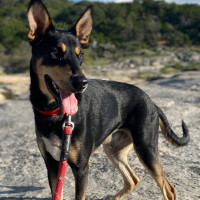Appearance of the Dobsky
|
| The Dobsky cross is a large dog, weighing between 18 and 41 kilos and measuring between 56 and 66 centimeters at the withers. His general appearance will generally be an equal blend of his two parents, but you can be sure that he will be strong and athletic. His face will be a pleasing blend of a no-nonsense dog and a cheeky Siberian Husky smile. His eyes may be brown or blue, or perhaps a little of both. His ears will be large and triangular, and his muzzle and tail will be long. The Dobsky cross will inherit any combination of coat colors from either parent, be it black and rust or gray and white, and it may inherit markings from either parent, be it the Siberian Husky mask or the Dobermann eyebrows. His double coat will be thick-textured and straight, and will generally take on a length in the middle of that of both parents, so you should expect him to have a medium-length coat. He will shed moderately throughout the year, and will undergo a full molt each molting season. |
Temperament of the Dobsky
|
| Like the Pomsky, the Dobsky is a loyal, protective dog who loves his family more than anything else in the world. At first, he'll be aloof with strangers and bark to warn you of their presence, but once he understands that his family wants them around, his sociable Siberian Husky nature will take over and he'll want to make friends with them in no time. This mixed breed offers an excellent balance between sociability and the protection of both parents. Because he loves you so much, you can be sure he'll be an intense dog who wants to spend every minute in your company. This is great if you like this trait in a canine companion, but for people who prefer a more independent dog, you may want to consider another breed. But if you're looking for a canine shade that will shower you with kisses and affection, then look no further than this dog. Because of his needy nature, he can suffer from separation anxiety, so he needs to be placed with a family who can guarantee to be home with him most of the day. This is a problem that will have to be resolved during the puppy's training. Fortunately, every minute spent with the Dobsky will be full of laughter and fun, and you can be sure that you'll never be bored with this dog. He'll always be up for a game of fetch, a long weekend hike or entertaining you with his chatty personality. Just make sure you have plenty of energy to give him back. |
Needs and activities of the Dobsky
|
| Like most Siberian Husky crosses, the Dobsky needs 60 to 90 minutes of intense exercise a day. It therefore needs to be placed in an active family that can guarantee this level of exercise. Don't underestimate this dog's energy, because if he doesn't get what he needs, he'll become destructive and behavioral problems will start to appear. But if you can do this, then you'll make an ideal couple, that's for sure. As a large dog with a lot of energy, the Dobsky needs to be placed in a home with plenty of space both inside and out. His garden should be reinforced by high fences, because if this dog takes after his Siberian Husky parent, he'll climb those fences with ease. As long as he's well socialized as a dog, he'll be happy to live with other pets. Thanks to the calmer behavior of its Dobermann parent at home, this dog is also suitable for homes with children, but make sure you supervise it as you would any other dog. The Dobsky has the potential to become very overprotective of its family, and this is an aspect that needs to be taken seriously during puppy training. Firstly, he needs to be socialized with dogs of all shapes and sizes, other animals and humans outside the family unit, so that he understands that most other beings are friends and not food. Secondly, the Dobsky would benefit from obedience training so that he understands who's boss and doesn't challenge your authority as master. Take a look at these tips for socializing an overprotective dog, which, when used as a dog, can prevent him from becoming overprotective in the first place. Because he's likely to become anxious when separated from his family, it's important to crate train him as a puppy, as this will not only give him a safe space when he's on his own, but also peace of mind when you need to leave him to his own devices. Choosing a crate for a more anxious dog is a good idea, as you won't have to worry about him becoming destructive. |
Maintenance of the Dobsky
|
| The Dobsky has a thick double coat that requires thorough brushing 2-3 times a week. If its coat resembles that of its Dobermann parent, it may be less, and if its coat more closely resembles that of its Siberian Husky parent, it may be more. As this is a generally clean breed of dog, you should only bathe the Dobsky once every 2 or 3 months. If he gets very dirty between washes, don't be afraid to rinse off the dirt, but avoid using products too often, as you risk damaging the natural oils in his coat. His big ears should be cleaned once a week to prevent bacteria build-up, and make sure you keep a close eye on his eyes and teeth. |









 English (United Kingdom)
English (United Kingdom)